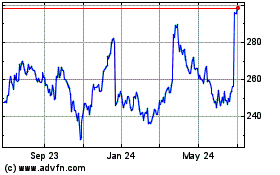UPS, FedEx Fees on Heavy Packages to Hit Consumers and Merchants
December 30 2019 - 9:04AM
Dow Jones News
By Paul Ziobro
FedEx Corp. and United Parcel Service Inc. are escalating their
war on bulky items by levying $24 fees on packages weighing more
than 50 pounds.
Previously, packages weighing more than 70 pounds triggered
additional handling surcharges. But the carriers are lowering their
thresholds as part of an annual round of rate increases that could
cause millions of packages to be hit by the fee -- or force
customers to change their shipping practices to avoid it.
The number of packages affected by the change could be
significant. Neither company responded to questions about the
estimated revenue the new fees would generate, but Shipware LLC, a
shipping consulting firm, estimates that 14.5% of packages sent by
its 100 largest shipper clients would be hit by the $24 fee under
the new rules, up from 8.4%.
"The impact is alarming," said Trevor Outman, Shipware's founder
and co-chief executive. "For some, the cost increase will be in the
millions [of dollars]. For others, it will be hundreds of
thousands."
Boxed Wholesale, an online startup that sells batteries, laundry
detergent and water in bulk, aims to ship orders in as few boxes as
possible and currently avoids shipments anywhere near 70 pounds.
The new weight limits could mean that Boxed will split up orders
more often.
"Customers who get their order in one box may now get it in
two," said Joe Bobko, Boxed's vice president of transportation.
Multiple boxes means higher costs for shipping, labor and
packaging, according to Mr. Bobko, and increases the odds that the
customer may not get their whole order at the same time.
The pricing changes may also mean carriers must make additional
stops at individual homes, which is why Mr. Bobko has been meeting
with UPS, its carrier, to try to minimize the impact. He said the
two sides "have reached an agreement that is favorable to both
parties."
While shipments with multiple items could get split up to avoid
the fee, others could be stuck. John Haber, CEO of Spend Management
Experts Inc., another shipping consulting firm, said some examples
of products weighing between 50 and 70 pounds include dog food,
lounge chairs, exercise equipment, home theater systems, mini dirt
bikes and medical devices.
"It's massive for certain shippers," Mr. Haber said.
FedEx and UPS say the changes to the threshold are being made so
that they are properly compensated for the increasing number of
large and heavy packages that are moving through their networks as
things like televisions, furniture and auto parts are increasingly
ordered online. Often, those bigger packages don't easily move
through automated facilities increasingly designed for e-commerce
packages, which are typically lighter and smaller, and can require
additional handling.
"These changes will ensure that we continue to provide the level
of service that our customers expect while responsibly managing
capacity through our network," a FedEx spokeswoman said.
The changes went into effect at UPS on Dec. 29. FedEx's new
rates start Jan. 6.
The changes were announced in recent weeks as part of the annual
rate increases carriers impose on shippers. As in years past, FedEx
and UPS said prices, spread across various weights and distances,
will rise 4.9% on average.
Mr. Outman estimated that a 50-pound parcel shipped over 1,000
miles using UPS Ground service could cost more than $75 to ship
under the new rates, compared with about $48 under previous rates.
That example applies to the carrier's list prices, so the impact
could be lower based on negotiated prices.
Boxed's Mr. Bobko said he understands carriers wanting packages
that are easier to handle but that he doesn't think assigning an
arbitrary weight limit works in all cases.
"A poorly packed 40-pound package may be more difficult for the
carrier to handle than a well-packed 69-pound package," he
said.
Write to Paul Ziobro at Paul.Ziobro@wsj.com
(END) Dow Jones Newswires
December 30, 2019 08:49 ET (13:49 GMT)
Copyright (c) 2019 Dow Jones & Company, Inc.
FedEx (NYSE:FDX)
Historical Stock Chart
From Mar 2024 to Apr 2024

FedEx (NYSE:FDX)
Historical Stock Chart
From Apr 2023 to Apr 2024
